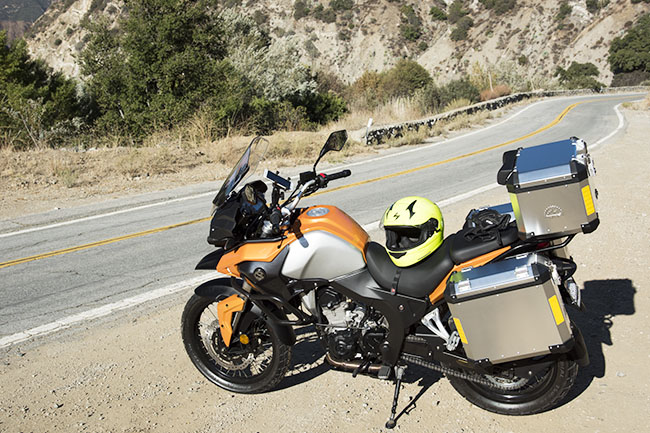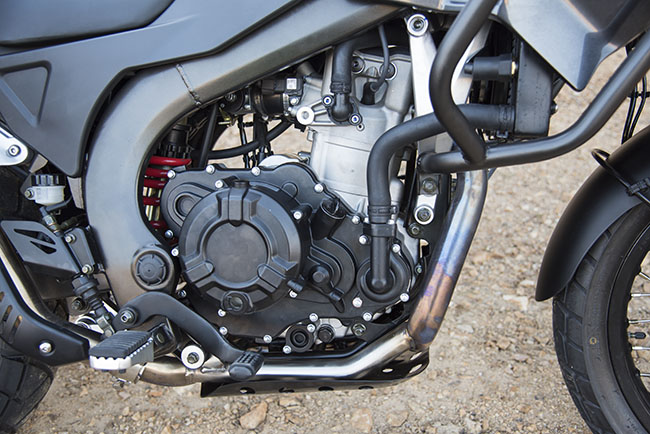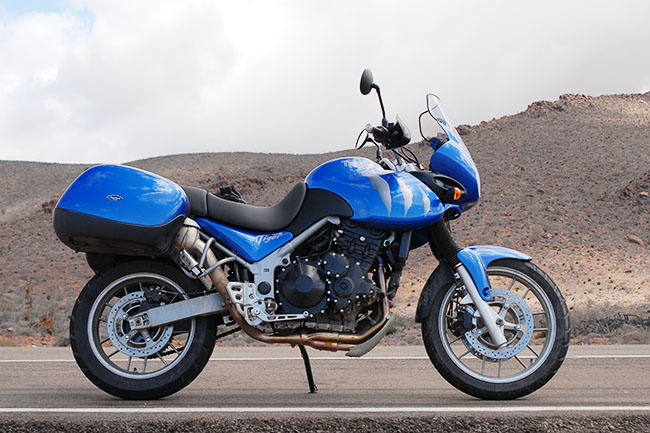
The next two blogs (this one and the next) address more differences between the RX3 and the RX4, including the weight, the dash and instrumentation, the rear fender, tire sizes, the radiators, the radiator bottle fill port, the kickstand, the rear brake and gearshift levers, the rear wheel adjust mechanism, the swingarm, and the engine mounts. This blog will focus on the bike’s weight and the two bikes’ highway performance. I’ll sweep up the other differences mentioned above in the next blog.
Let’s talk about the 450-lb gorilla in the room first, and that’s the RX4’s weight. The RX4 is a heavier bike than the RX3, and I guess the question is: Is this a good thing or a bad thing? It’s all a question of perspective and intended purpose.
For starters, I still don’t have an accurate, measured weight on either bike. That’s a shame on me, although I will tell you that I tried.
My plan was to get the RX4 weighed first, and then return with my RX3 to do the same. I took the RX4 to our local certified truck scale, but the bike was too light to register on the scale and a loudspeaker-borne voice basically told me to get out of Dodge. It was a scary experience. There’s a monstrous Petro truck stop on the I-10 freeway about 10 miles from where I live, and I thought it would be a simple matter to roll the RX4 onto the scales and come back with The Number. That was my plan, anyway.
I entered the super-busy truck stop through an area teaming with idling 18-wheelers, engines barking and belching, crammed together weighting (or is that waiting?) to funnel onto the Petro parking lot scales. On my RX4, I was acutely aware of three things: The guys driving these monsters couldn’t see me, the engine noise and fumes were overwhelming, and the RX4’s fat rear end (those Tourfella bags are wider than the bike’s handlebars) made maneuvering through the 18-wheeler maze a dicey proposition. The pucker factor was elevated, folks. Big time.
I made it through, though, and I was finally on a scale with a platform as long as, well, an 18-wheeler. There was this elevated control house sort of thing next to the platform. It wasn’t clear to me what was supposed to happen next, as I couldn’t see anybody running the operation, and there was no digital or analog readout telling me the weight. I stopped the bike and dismounted, and I walked toward the elevated control house when an electronic voice from the Heavens boomed. It was way louder then the idling diesel engines surrounding me and I could tell: It was pissed. At me.
“Can I help you?” It didn’t come across as a request that implied an intent to be helpful. It implied anger. Seething anger. Directed at me. As a two-wheeler, I was but one-ninth the vehicle I was supposed to be.
Well, yeah, I want to weigh my bike. I mean, why else would a normal person be here?
“You’re setting off my alarms.”
Sorry about that, dude. What alarms?
“You’re too light and my alarms are going off!”
I want to weigh my bike (sometimes repetition helps, I thought).
“You need to get out!” There it was. No more implying or inferring. It was out in the open now. It was as if I was wearing a MAGA hat on the Harvard campus. I was not welcome.
Okay, I can take a hint. Hell, a weight is just a number anyway.
Which brings me to my next point. What’s in a number?
Whatever the answer is to that question, I can tell you these three things: One, the RX4’s official number from Zongshen is 450 lbs. As I said before, I don’t know if that is the right number, but I suspect it is not. Two, the RX4 is substantially heavier than my RX3, and weigh heavier (or should that be way heavier?) than my TT250. It feels it, and it feels to me like the weight rides higher. Three, the RX4 is a substantially better road bike than the RX3, and the bike’s added heft and longer wheelbase (along with that marvelous 450cc motor) probably plays a role here. Anyway, the bottom line here is this: There’s no Joe Berk official weight yet (read that to mean a weight actually measured on a scale).
Like I said, I can feel the difference in heft between the RX3 and the RX4. It’s enough to make me wonder: Am I man enough to take this puppy off road? I suppose I could be. I know there are a few guys who actually take GS 1200 BMWs off road, and those things have seat heights and weights that require altimeters and maybe truck scales to measure. But would I want to go off road?
The short answer, I think, is this: If your main objective is off-road riding, there are other choices. I’d go for my TT250 or something else. If you are primarily a road rider, though, with the occasional off-road excursion, then the RX4 is a good choice. In my opinion, the RX3 would be better off road, but that’s just what I said it was: My opinion. Your mileage may vary, as they say. I was thinking about the stretch to the Sierra San Francisco cave paintings in Baja, and to me, I’m right at the limits of what I feel comfortable with on that gnarly stretch on my RX3. It’s heavily rutted, there are big boulders, and it’s a challenge. But then, I freely admit I’m not a dirt biker. I know there are guys reading this who are thinking they would have no problem taking the RX4 off road. If you’re one of them, you’re probably right.
If you are primarily a road rider, though, the RX4 is the better choice. I put about 100 miles on the RX4 on freeways and surface streets here in So Cal, and I can tell you this: The RX4 is clearly a more capable road machine than is the RX3, especially at freeway speeds. I didn’t get a long enough stretch to measure the RX4’s top speed, but I can tell you there were spurts where I cranked it up to an indicated 99 mph and there was still more left. That’s indicated (not actual) top speed, and the speedo is 10-12% optimistic. Zongshen claims a top speed of 97.5 mph for the RX4, and that’s probably accurate. The RX4 is a bike that can cruise comfortably at 80+ mph all day long; the RX3 has essentially run out of steam at that speed. The RX4 makes running with the big dogs seem easy. It is rock steady at high speeds, and it’s comfortable. It feels secure.

In many ways, the RX4 reminded me more of my Triumph Tiger than it reminded me of my RX3. The Triumph was essentially a touring machine/sports bike styled like an off-roader with saddlebags. The Triumph was heavy and I only took it off road once on purpose (and that was enough). I rode the Triumph off road a few more times when I had to in Mexico, but it really was not an off-road bike. I know there are guys who ride the big Tigers off road, but it’s not where the bike wants to be. It wants to be headed to the next state, or maybe the next international border. That’s what the RX4 wants, too.

I’ll make a prediction: Within the next two years, someone (perhaps several someones) will do the Iron Butt on the RX4. I don’t mean a single 1000-mile Baby Butt day (good buddy Rob Morel has already done that on his RX3). I’m talking the full-tilt boogie here: The 11,000-mile, 11-day Iron Butt. I think that’s going to happen. And I think the RX4 is the bike that will do it.
I was talking to Steve Seidner about this a day or two ago, and he asked me to mention to you that CSC is taking deposits now on the RX4 (here’s a link to get to their page for placing your deposit). CSC will sell a lot of RX4s. The bike is that good.
